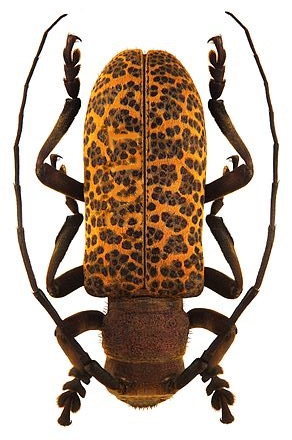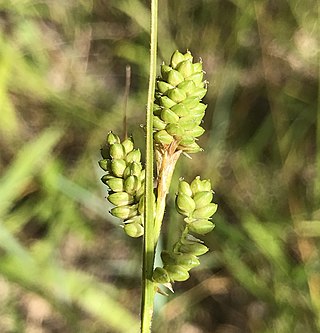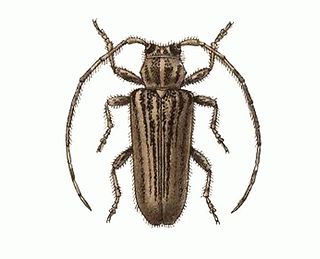Hirsutella is a genus of asexually reproducing fungi in the Ophiocordycipitaceae family. Originally described by French mycologist Narcisse Théophile Patouillard in 1892, this genus includes species that are pathogens of insects, mites and nematodes; there is interest in the use of these fungi as biological controls of insect and nematode pests. The teleomorphs of Hirsutella species are thought to belong to the genus Ophiocordyceps.

Anacampsis hirsutella is a moth of the family Gelechiidae. It is found in Austria, Switzerland, France and Italy.
ESTOLAS was a proposal for a hybrid type of aircraft that was developed from 2012 to 2014 in a project funded by the European Commission.

Estola is a genus of longhorn beetles of the subfamily Lamiinae, containing the following species:

Carex hirsutella, the hairy green sedge or fuzzy wuzzy sedge, is a species of North American sedge that was first described by Kenneth Mackenzie in 1923. It ranges from Texas, throughout most of the central and eastern United States, north to Ontario and Quebec.
Estola annulipes is a species of beetle in the family Cerambycidae. It was described by Stephan von Breuning in 1940. It is known from Brazil.
Estola assimilis is a species of beetle in the family Cerambycidae. It was described by Stephan von Breuning in 1940. It is known from Brazil.
Estola benjamini is a species of beetle in the family Cerambycidae. It was described by Stephan von Breuning in 1940. It is known from Colombia.
Estola brunnescens is a species of beetle in the family Cerambycidae. It was described by Stephan von Breuning in 1940. It is known from Colombia and Venezuela.
Estola nigropunctata is a species of beetle in the family Cerambycidae. It was described by Stephan von Breuning in 1940. It is known from Brazil.
Estola nodicollis is a species of beetle in the family Cerambycidae. It was described by Stephan von Breuning in 1940. It is known from Brazil.
Estola obliquelineata is a species of beetle in the family Cerambycidae. It was described by Stephan von Breuning in 1940. It is known from Brazil.
Estola rufa is a species of beetle in the family Cerambycidae. It was described by Stephan von Breuning in 1940. It is known from Brazil.
Estola freyi is a species of beetle in the family Cerambycidae. It was described by Stephan von Breuning in 1955. It is known from Trinidad.
Estola basinotata is a species of beetle in the family Cerambycidae. It was described by Henry Walter Bates in 1866. It is known from Brazil, French Guiana, and Ecuador.

Estola vittulata is a species of beetle in the family Cerambycidae. It was described by Henry Walter Bates in 1874. It is known from Panama, Mexico and Venezuela.
Estola cerdai is a species of beetle in the family Cerambycidae. It was described by Martins and Galileo in 2009. It is known from French Guiana.
Estola acrensis is a species of beetle in the family Cerambycidae. It was described by Galileo and Martins in 2009. It is known from Brazil.
Estola insularis is a species of beetle in the family Cerambycidae. It was described by Blair in 1933.
Estola kuscheli is a species of beetle in the family Cerambycidae. It was described by Juan Barriga, Tomás Moore, and Danilo Cepeda in 2005. It is known from Chile.



